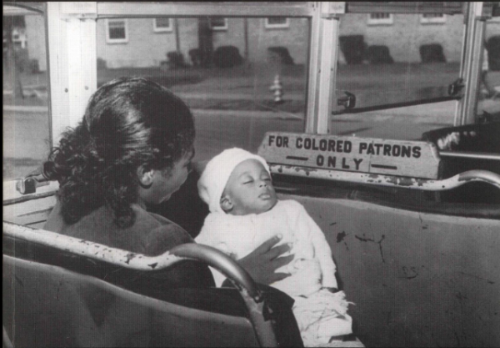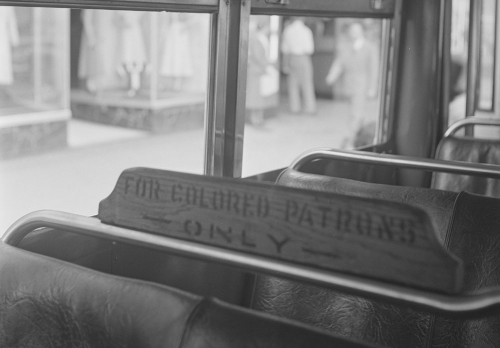Jim Crow Museum
1010 Campus Drive
Big Rapids, MI 49307
[email protected]
(231) 591-5873
Q: Hello, I saw your YouTube video at 4:07 you show a sign that says "For colored patrons only" I was wondering if that was not for buses but in fact for trolleys. New Orleans car I rode at a museum actually saw holes in the seat which I assumed were for posting such unfortunate signs. The reason they would have to be moved is because a lot of trolleys are bi-directional meaning either end can be the front as there are controls on both ends. So, when the trolley changed directions, the front would then become the back and vice versa necessitating the moving of the signs.
~Facebook message
A: You are correct that some bi-directional trolleys in New Orleans used similar signs during the Jim Crowera. Interior views of a 1950s New Orleans streetcar from The Historic New Orleans Collection, show a similar “For Colored Patrons Only” sign in Streetcar No. 930 (Historic New Orleans Collection).
Edward Bradley, also known as the NOLAHistoryguy, referring to the 1950s New Orleans streetcars, posted the same image and stated:
“Separate but equal was problematic on public transit. While the Canal and West End lines looped around Liberty Place, many of the lines operated “point to loop.” When the streetcar reached the outbound end of the line, the crew changed the direction of the electric poles on the roof. They also changed the direction of the seats. With the seats flipped, the race screens were at the front of the car. Black folks would get in and sit, but had to keep going to the back as white riders boarded. On crowded runs, it got to the point where black riders stood in the aisle. White riders kept moving the screens back" (Branley, 2019).
Another streetcar view from 1940s New Orleans that is in a Georgia College and State University curriculum,has the caption:
“…an example of the partitions being moved to accommodate more room for White or African American passengers. Notice how on the right side of the car, the partition is farther forward than the partition on the left side of the car, which is cut off here on bottom left corner" (Sallie Ellis Davis House).
However, the movable signs were also used in buses. In a photo taken by Alexander (Alex) Rivera, the same type of sign as was seen in the New Orleans streetcars also appears on a bus seat in a 1955 photo taken in Montgomery, Alabama. Also, an article about an exhibit of the photography of Sam Shaw includes an image of a "For Colored Patrons Only" sign that appears to be on bus seating.

Mother and child sit on a bus with the sign "For Colored Patrons Only" on seat in front. Photo taken by Alexander (Alex) Rivera 1955.

"For Colored Patrons Only" sign on bus seat. Photo taken by Sam Shaw 1950s.
Thanks for your question and helping us show how the same type of signs were sometimes used in both buses and in railcars.
~Franklin Hughes
Jim Crow Museum
2023
References
Buchsteiner Art Management GmbH. (n.d.). Remembering Sam… Sam Shaw. Buchsteiner Art Management. http://buchsteinerartmanagement.de/sam-shaw_en.html
Charles L. Franck Studio Collection at The Historic New Orleans Collection
https://catalog.hnoc.org/web/arena/search#/entity/thnoc-archive/1979.325.6222/streetcar-no.-930---interior-view-looking-to-%231-end
Educational Resources - Sallie Ellis Davis House. (n.d.). Lesson Plans: Plessy v. Ferguson, Georgia College & State University. https://www.gcsu.edu/sallieellisdavis/educational-resources-sallie-ellis-davis-house
Jim Crow Museum. (2013, April 29). The Jim Crow Museum [Video]. YouTube. https://www.youtube.com/watch?v=yf7jAF2Tk40
N.C. Central University Campus Echo. Page 3 (2008, January 30). Issuu. https://issuu.com/campusecho/docs/print_edition_january_30_2008
Nolahistoryguy. (2019, February 4). Race Screens on NOPSI 930 - Segregation on New Orleans transit. Edward Branley - the NOLA History Guy.
https://nolahistoryguy.com/category/history/post-wwii/page/5/